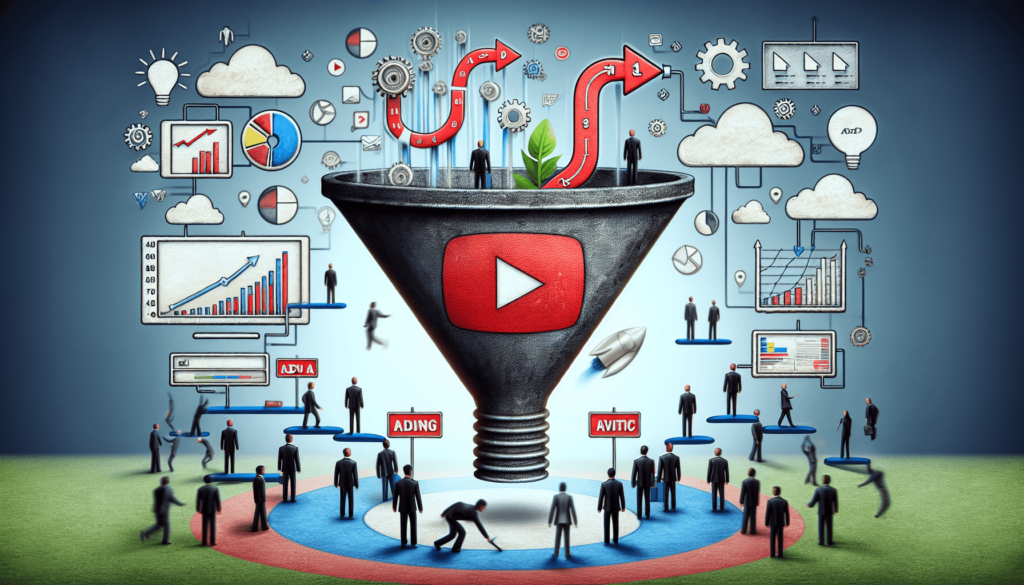Bright and early, you’re all set to boost your online marketing strategy by creating a YouTube ad funnel. Don’t fret, the process might seem daunting at first, but with a step-by-step guide, it’s simply a walk in the park! This article offers the necessary guidance that will pave your way to successfully develop a YouTube ad funnel, enhancing your brand visibility to new lengths. Get ready to ride this wave of digital marketing that can transform your audience engagement, video views, and overall business performance in such a positive way!
Understanding YouTube ad funnel
Before diving into creating a YouTube ad funnel, it’s crucial to understand what it is. A YouTube ad funnel is a pre-determined route through which you guide potential customers on YouTube from the initial stage of awareness about your product or service to a point where they decide to make a purchase. In other words, it’s a step-by-step guide on how to turn a viewer into a customer.
What is a YouTube ad funnel?
A YouTube ad funnel consists of a series of stages a potential customer passes before making a purchase. It works like a conventional marketing funnel, but mostly relies on video content. The stages usually start with awareness, move to consideration, and end with conversion. Each of these stages includes varying types of video content tailored to fit the audiences’ needs and mindset at that particular time.
Importance of YouTube ad funnel in digital marketing
Given that YouTube boasts over 2 billion monthly users, using a YouTube ad funnel can be a very potent tool in your digital marketing arsenal. YouTube ad funnels are essential because they help businesses to plan, organize, and implement a sophisticated, targeted marketing strategy. They allow marketers to engage with their audience at various stages, thus refining their content and approach according to the audience’s needs.
Difference between a YouTube ad funnel and a traditional marketing funnel
While both the YouTube ad funnel and the traditional marketing funnel follow a similar strategy of guiding the customer from awareness to conversion, the main difference lies in how these strategies are executed. Traditional marketing funnels can utilize various marketing channels such as emails, flyers, TV ads, etc. On the other hand, a YouTube ad funnel strictly employs video content shared on YouTube for engaging and converting the viewers.
Familiarizing with YouTube ad types
To maximize the effectiveness of your YouTube ad funnel, it’s essential to familiarize yourself with the different YouTube ad types. This will allow you to create and optimize your campaign according to the format that best suits your message and goals.
Overview of YouTube ad types
YouTube offers a variety of advertisement types that brands can incorporate into their marketing strategy. These includes Skippable video ads, non-skippable video ads, bumper ads, TrueView ads, display ads, and sponsored cards.
Defining skippable video ads
Skippable video ads are the most common type of YouTube ads. As the name suggests, viewers can skip these ads after 5 seconds. However, your brand message should be compelling enough to encourage viewers to watch beyond the skip mark.
Explaining non-skippable video ads
Non-skippable video ads cannot be skipped by the viewers. These ads are usually 15 – 20 seconds long and deliver a complete brand message without the fear of the viewer skipping the ad.
Understanding bumper ads
Bumper ads are 6-second, non-skippable ads that are typically displayed before the selected video. These short ads work perfectly as a ‘teaser’ or to reinforce a more extended campaign message.
Overview of TrueView ads
TrueView ads are YouTube videos that are promoted by the advertiser, where the advertiser only pays when a viewer watches the ad. They come in two formats – In-Stream and Discovery. In-Stream ads play before, during or after other videos, while Discovery ads appear alongside other YouTube videos, in YouTube search pages or on the Google Display Network.
Details about Display ads
Display ads appear to the right of the feature video and above the video suggestions list. These ads only appear on desktop and are a fantastic choice when looking to increase brand exposure and target a broad audience.
Exploring Sponsored cards
Sponsored cards are ads that appear within relevant videos. They are unobtrusive, and viewers can click to view more information about the promoted content.

Identifying target audience
Identifying who your audience is, is one of the fundamental steps to creating an effective YouTube ad funnel. A well-focused, audience-centered approach can significantly improve your ad performance.
Defining your target audience
To define your target audience, consider the type of people who would be interested in your product or service. Consider aspects such as their age, gender, location, interests, and lifestyle. Once you have that figured out, you can create ads that resonate well with your target demographic.
Researching audience behaviors and interests
Understanding your audience goes beyond just demographic information. It includes digging deeper into their online behavior, interests, and preferences.
Creating audience personas
Creating audience personas can be an effective way to understand your audience better. Audience personas are fictional representations of your ideal customers, created by researching the characteristics, preferences, and behaviors of your customer base.
Setting up YouTube channel
Before you can launch any YouTube ads, you need to have a well-structured YouTube channel in place.
Creating your business YouTube channel
Creating a business YouTube channel is a straightforward process. Ensure that the name of the channel resonates with your brand and is easily identifiable.
Completing channel ‘About’ section
The ‘About’ section of your channel gives viewers a quick summary of what to expect from your channel. It should be concise yet informative, stating the nature of your business and the type of content you’ll be posting.
Creating appealing channel art
Channel art can significantly impact your channel’s first impression. Aim for clean, visually appealing graphics that represent your brand’s style and message effectively.
Adding channel links
Channel links direct your viewers to your other social media profiles or website, ensuring a comprehensive digital presence.

Creating engaging content
Once your channel is set up, the next step is to create engaging content.
Creating high-quality videos
High-quality videos aren’t just about resolution but also about the quality of content. Ensure that your videos are visually appealing, audible, and provide valuable information.
Ensuring relevance of content to your target audience
Ensure the content of your video is relevant, timely, and resonates with your target audience.
Incorporating persuasive call-to-actions
A powerful call-to-action (CTA) gives your viewer a clear direction after watching your video. CTAs can guide viewers to like your video, subscribe to your channel, visit your website, or make a purchase.
Optimizing videos for SEO
Just creating great video content is not enough. You also need to optimize your videos for search.
Understanding YouTube SEO
YouTube SEO involves optimizing your videos, playlists, and channel to be discoverable to people searching for videos like yours.
Writing effective video titles and descriptions
Your video titles and descriptions should be compelling and include relevant keywords to increase your videos’ visibility in YouTube’s search results.
Adding relevant tags
Tags help YouTube understand your video’s content and contextual relevance. This influences which videos YouTube will suggest alongside your video.
Using appropriate categories
Categorizing your video properly helps YouTube to group it with similar content, which in turn expands your video’s reach.

Using YouTube’s Video Ad Sequences
Video ad sequences allow you to string together a set of videos to tell a story over time.
Understanding ad sequence
An ad sequence is essentially a string of ads that follow a narrative. It is a feature that allows marketers to present a sequence of ads to individual viewers in a specific order, establishing an undisturbed storytelling experience.
Crafting storytelling ad sequence
A good storytelling ad sequence involves planning your message to flow cohesively from one ad to the next. Each video serves as a chapter in your brand’s story, guiding the viewer down the buyer’s journey.
Measuring ad sequence performance
YouTube provides analytics, which you can use to measure the performance of your ad sequences. This data can provide insights into drop-offs, impressions, and frequency of your ads.
Understanding YouTube advertising costs
One key aspect to understand before launching a campaign is how much YouTube advertising costs and how you can gain control over your spending.
YouTube advertising bidding system
YouTube operates on a bidding system, which means you only pay when viewers watch or interact with elements of your video. There are different types of bids like cost-per-view (CPV) and cost-per-thousand impressions (CPM).
Setting up a YouTube ads budget
Setting a budget for your YouTube ads not only helps you stay in financial control but also allows you to maximize your ROI. The budget should be set based on your marketing goals, the type of ad you want to run, and the duration of the campaign.

Analyzing and optimizing ad funnel
A crucial part of maintaining a successful YouTube ad funnel is analyzing and optimizing its performance.
Using YouTube analytics
YouTube analytics provides detailed data about who’s watching your videos, how they’re discovering them, and how they’re engaging with them.
Identifying metrics to track
Key metrics like viewer demographics, watch time, audience retention, and traffic sources can help you understand your ad’s performance and make necessary improvements.
Making necessary alterations to enhance performance
Depending on the insights you gain from your analytics, you might need to alter your ad content, targeting, or even ad type to improve performance and achieve better results.
Taking advantage of retargeting
Retargeting is an essential tool in your YouTube marketing arsenal to re-engage viewers who have interacted with your videos or ads in the past.
Understanding retargeting
Retargeting is a technique that involves displaying ads to people who have previously visited your website or interacted with your videos on YouTube, encouraging them to take further action.
Setting up YouTube ad retargeting
To set up retargeting, you need to create a remarketing list in Google Ads. This list includes users who have interacted with your channel or videos.
Building retargeting audience lists
Building a retargeting audience list allows you to segment your viewers based on their interaction level. This segmentation allows you to customize your ad content to better align with the stage of the funnel they are currently in.
In conclusion, creating a YouTube ad funnel involves multiple steps, including understanding the concept of the ad funnel, selecting the right ad formats, identifying the target audience, creating and optimizing content and videos, setting up and measuring ad sequences, and retargeting. It’s a highly effective strategy that can be used to increase brand awareness, engage users and drive conversions.






